Download as pdf
The Scientific Computing and Imaging (SCI) Institute is a trans-college, research-focused unit on the University of Utah campus. Our vision is to see applied computing transform disciplines in a way that benefits the U and society at large. Our mission is to bring together excellence in multiple domains applied to multidisciplinary and interdisciplinary problems of societal importance. We accomplish this through collaborative research in simulation, imaging, visualization, and scientific and data computing that drives the development and distribution of advanced software tools.
The result of executing this mission has been a 20-year history of success, growth, and impact, during which we have helped to define how thematic research institutes can flourish at the University of Utah. The SCI Institute now consists of 18 faculty from 4 departments and 2 colleges, with auxiliary appointments in 14 departments: Genetics, Orthopedics, Radiation Oncology, Neurology, Neurosurgery, Psychiatry, Internal Medicine, Mathematics, Physics, the School of Computing, and Electrical, Biomedical, and Mechanical Engineering. Our research is supported by a team of approximately 170 administrative and scientific staff, postdocs, graduate students, and undergraduate research interns. We occupy a dedicated space of 25,000 sq. ft. in the Warnock Engineering Building, which we also designed to maximize interactions and the easy flow of ideas and collaborations.
Since graduating from a Center to a University Institute in 2000, the SCI Institute has established itself as an internationally recognized leader in visualization, scientific computing, simulation, and image analysis applied to a broad range of domains. Our individual technical strengths are well recognized. For example, the visualization team at the SCI Institute is ranked by CSRankings (http://csrankings.org) as the top visualization group internationally for their publications in large-scale, interactive, and information visualization. Such research allows members of the Institute to create software approaches and tools that are the building materials for bridges linking departments and colleges on and off the campus – bridges that enable the traffic of ideas nationally and internationally.
Research Objective:
The overarching research objective of the SCI Institute is to conduct application-driven research enabled by creating new scientific computing algorithms, techniques, tools, and systems. The applications of this research span the broad space of modern science, starting from our origins in the biomedical use of electric fields and now encompassing such fields as multimodal biomedical and geophysical image analysis, biomechanics, genetics, cancer, materials science, climate, astronomy, manufacturing, defense, and energy. The scientific computing capabilities are the core expertise of SCI Institute researchers and include simulation and modeling of electric fields, fluid dynamics, solid and fluid mechanics, computational biomechanics and electrophysiology, parallel computing, inverse problems, data science, machine learning, visualization, and image processing and analysis. The computational scientists within the SCI Institute seek to develop the computer science of tomorrow in the context of pressing applications problems today; the domain scientists within the Institute seek to develop the new science and engineering of tomorrow using computational methods available today. This synergistic amplification is fundamental to the SCI Institute’s success.Education and Training Mission:
We further amplify the impact of our research goals through our education and training mission. The SCI Institute is proud to have graduated over 400 graduate students and postdoctoral fellows (the Institute has also interned nearly 100 undergraduates), who have helped publish over 3500 articles, with multifaceted training at the cutting-edge of computationally enabled research. SCI Institute graduates move into faculty positions at universities internationally and also become innovators with companies such as Exxon Mobil, NVIDIA, Google, Intel, and Medtronic. As a further commitment to our educational setting and mission, we also provide training for staff, especially developers/programmers. Our technical `graduates’ occupy influential positions throughout the local and national ranks of the computer industry, including NVIDIA, Google, Apple, and Pixar/Disney Animation, even achieving Academy Awards.
Research Highlights:
Building bridges that span the boundaries of disciplines and allow computing to transform other fields requires both special individuals and a special attitude. We have sought out and encouraged those special individuals since the inception of SCI. We have allowed them to create teams – teams within the SCI Institute to build one abutment of the bridge and teams that construct the arch that leads to the other abutment located within a remote discipline. The results include over a dozen large-scale, cross-disciplinary research centers and many more funded research projects that build and then use these bridges to transport ideas, data, and solutions. In this document, we will highlight three such centers that illustrate both the common approach of using computation (and, in particular, software tools) to build bridges and the broad range of specific, transformative impacts these bridges have enabled.(1) The NIH Center for Integrative Biomedical Computing (CIBC) began in 1999 with a focus on bioelectric field simulation. With the help of continuous NIH funding, the CIBC has pursued original research and collaborations around the world to create a complete suite of image-based modeling approaches, techniques, and tools. The results of the CIBC include hundreds of research articles, several national workshops, and a set of open-source software tools. These products allow scientists across a range of biomedical disciplines to a) process and analyze image data of all modalities and space scales (Seg3D), b) extract metrics and create geometric models from the structures in those images (BioMesh3D, Cleaver, and ShapeWorks), and then c) conduct numerical simulations of bioelectric phenomena based on those models within a flexible and extensible problem-solving environment (SCIRun). A set of scientific visualization tools (ImageVis3D, map3d, SCIRun) provides access to the information at each step in this pipeline. Core faculty within the CIBC came from the University of Utah’s School of Computing and Department of Biomedical Engineering, as well as Electrical and Computer Engineering at Northeastern University. Examples of specific bridges that have resulted from the CIBC include those connecting computing expertise to cardiologists who wish to place defibrillators, analyze measurements from sensing electrodes, or decide on therapeutic interventions, all guided by patient-specific images and anatomical and functional models. Other bridges connect computing and simulation experts to neurosurgeons and neurologists who wish to model the stimulation of the brain and guide therapies in patients suffering from motor-neuron disorders, e.g., Parkinson’s disease. Still other bridges end in orthopedic centers, which use medical images of the hip, shoulder, or knee to predict noninvasively the risk of degenerative disease and thus guide future personalized therapies. The last set of bridges links to basic biomedical scientists in genetics who wish to understand the impact of specific genes on regulatory networks in cells. These bridges help to connect the medical campus with the academic campus here at the University of Utah – making it OneU.
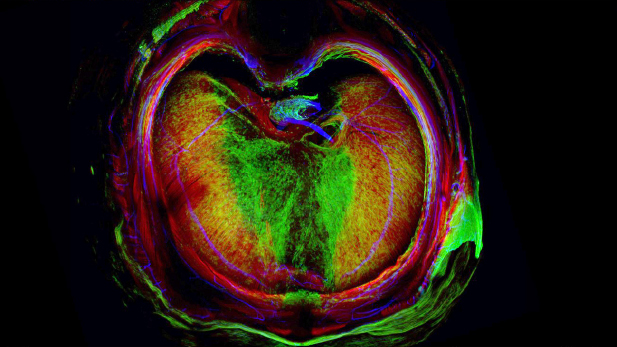 |
| FluoRender was designed especially for neurobiologists. It is an interactive tool for multi-channel fluorescence microscopy data visualization and analysis. This project was a collaboration between SCI and Neurobiology and Anatomy. |
(2) CSAFE, the Center for the Simulation of Accidental Fires and Explosions (1998-2010), was one of five major centers selected by the Department of Energy's Advanced Simulation and Computing (ASC) Program. CSAFE's faculty and researchers came from the SCI Institute, the School of Computing, and the Departments of Chemistry, Chemical Engineering, Materials Science and Engineering, and Mechanical Engineering to produce cutting-edge research in simulating complex physical phenomena, including reacting flows, material properties, multimaterial interactions, and atomic-level chemistry. The SCI Institute provided the bridge to link these activities through the Uintah parallel simulation software. Uintah is based upon new research in parallel computing, software frameworks, and visualization and in methods such as the Material Point Method (MPM). Uintah made it possible to solve the CSAFE target problem of an exploding container in a fire. Subsequent extensions of Uintah with the University of Utah’s Institute for Clean and Secure Energy led to one of three large NNSA PSAAP2 centers at Utah (2014-2020), for which SCI researchers developed Uintah into an exascale-ready asynchronous many-task (AMT) runtime system that is to run on the first US exascale computer, Aurora. This sequence of research and software development has generated over $90M of federal funding, and the Unitah infrastructure has spawned other projects, such as MSME, described below.
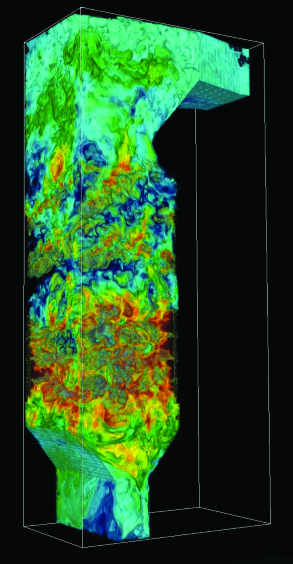 |
| Simulation of oxy-combustion boiler. This research is part of the Carbon Capture Multidisciplinary Simulation Center, a collaborative project among SCI, the School of Computing and the Department of Chemical Engineering. |
(3) The Army Research Laboratory, Multi-Scale Multidisciplinary Modeling of Electronic Materials (MSME) project required the SCI Institute to construct an international team of bridge builders from government, industry, and academic institutions (University of Utah, Boston University, Rensselaer Polytechnic Institute, Pennsylvania State University, Harvard, Brown University, University of California, Davis, and Politecnico di Torino). Their goal was to enable fundamental research in the quantitative understanding of electronic materials, from the smallest (nanometer) to the largest (meter) relevant scales. The drivers of this project in Utah came from the Departments of Chemistry and Materials Science and Engineering and the School of Computing. The main computational challenge was to build bridges across the models that capture behavior at each of the scales, to allow traffic from one scale to reach the next and thus to achieve true multiscale models of materials. This flow of traffic requires high efficiency, so the bridges had to provide all the necessary on-ramps and wide, smooth surfaces to allow traffic to flow in both directions across each bridge without bottlenecks or disruptions. The resulting bridge construction was based on our Uintah system, described above, which has become a highly efficient, distributed simulation and modeling environment that is capable of connecting models seamlessly. The results of these bridged models include new understanding and improved domain-specific electronic systems of sensors and electronics that have enhanced battle-space capabilities and enabled novel, efficient power and energy devices.
Industry impact:
A range of industry partners also benefit from our bridging between academic research and novel applications in a variety of domains. A core volume-rendering capability developed within the CSAFE center, Real-Time Ray Tracing (RTRT), then spawned a company called RayScale, which was purchased by NVIDIA. A consequence of this purchase was the creation of the Salt Lake City based NVIDIA research center. The SCIRun problem-solving environment was the basis for a spin-off company called Visual Influence, which later merged with Numira Biosciences to analyze and visualize the images from their micro-CT technology. We also continue to pursue contract engineering with companies such as Medtronic, Boston Scientific, Catheter Precision, GE, Microsoft, and Philips Medical. The key value of the SCI Institute in these settings has been our ability to bridge gaps between fields, for example using image analysis techniques learned from our research with radiologists to inform the processing of seismic images for the oil and gas industry.
Why the Need for SCI?
The SCI Institute represents a new and effective organizational structure to gather agile, outward-looking, technical experts into a malleable resource that can enable a wide range of cross-disciplinary research just as the demands of that research motivate advances in our core knowledge and technologies. This organization is often orthogonal to the traditional administrative structures at a university, structures that mimic—and in some sense entrench—traditional disciplinary boundaries. Although such disciplinary units striving to achieve excellence is natural and healthy for the university, such a paradigm leaves untapped the rich space of enquiry that often lies at the interfaces between disciplines. Research within such departmental units can also suffer from a lack of access to the technologies needed to make transformative progress. The SCI Institute was founded to enable computational technology to reach into the traditional disciplines by building bridges between computational and domain scientists. The SCI Institute also took on a mission to use computation to build other bridges between the disciplines, to enable domain scientists to rise above and over the disciplinary walls and connect in completely novel ways to other specialists.
SCI Institute Structure:
The principles for this structure came from observations about how cross-disciplinary efforts work but can also be impeded on a university campus: 1) The natural incentive structures within the university do not necessarily help (and sometime inhibit) cross-disciplinary hiring and research. Faculty seek to clone themselves and hire more of the same; 2) Discipline-centered strategic plans often focus on discipline-building and not cross-disciplinary enhancement. As a natural consequence, departments—and perhaps colleges—form discipline-centric strategic plans that guide their decisions, such as resource allocation and hiring. Resource use can be perceived as optimal when it stays within a department or a college. However, a consequence of this strategy is that departments, while optimizing their particular needs, might miss out on university-level synergies. If the vision is not only to cross disciplines but also transform them, then university administrations should not isolate cross-disciplinary efforts but instead integrate them; and 3) Cross-disciplinary research is important alongside disciplinary research, not as a replacement for it. Both disciplinary and cross-disciplinary research should be encouraged and incentivized. The SCI Institute uses computational research and expertise to achieve both goals.
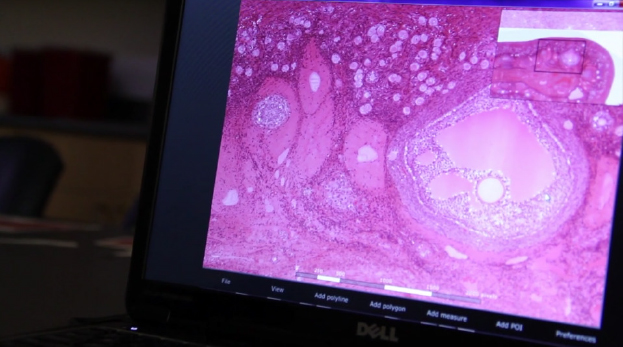 |
| ViSOAR: The impetus for the collaboration was to build a tool for the classroom setting that would replace the traditional use of microscopes for viewing histology slides and provide the ability for annotation on the image. A single scan of a slide can produce multi-gigapixel images that require tens of gigabites of raw data -- thus a tool that can process these data is essential. |
University of Utah Support for SCI:
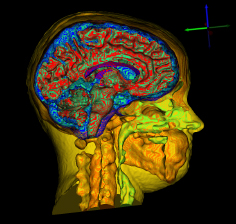 |
| Female head and brain model data repository and pipeline. The data repository includes high-resolution T1 and T2-weighted magnetic resonance images (MRI), diffusion-weighted images (DWI), functional MRIs (fMRIs), and electroencephalogram recordings. From these images, we created diffusion tensor images (DTI), an eight-layer head and brain segmentation, and a 3D tetrahedral mesh in two resolutions, and we performed isotropic and anisotropic forward simulations studies. |
With these three observations in mind, the University has set up a model to support the SCI Institute and enable its role in building bridges to transform disciplines. Core faculty positions within the SCI Institute are provided directly by the Office of the Senior Vice President for Academic Affairs with the requirement that we partner with a department to provide academic (tenure-line) homes. The SCI Institute’s 18 tenure-track faculty members are drawn from the School of Computing and the Departments of Biomedical Engineering, Mathematics, and Electrical and Computer Engineering, and most faculty members have adjunct appointments in various departments across campus. If one views disciplinary boundaries as fences, then this dual organization allows SCI Institute faculty—and teams of SCI faculty with complementary expertise—to see over these disciplinary fences and propose win-win scenarios that transcend discipline, department, and college boundaries. In addition to faculty support, the University provides both core support (reviewed at regular intervals) and returned overhead from external grants to fund the organizational and administrative needs of the Institute. This formula ensures a balance between guaranteed basic support and highly incentivized growth tied to success in external funding. To support the maintenance of IT systems within the SCI Institute, there is a federally approved, mandatory, FTE-based, facility cost charged to all grant proposals. All purchases of major computer hardware must be funded from external mechanisms. We are grateful for the continuing support (for example, the current returned overhead model) from an administration dedicated to investing in this model for the good of the University.
SCI Strengths:
The SCI Institute is composed of bridge builders. We build bridges between areas, not just roads within a given area or even roads that connect adjacent areas, but bridges that cross barriers and cover broad spans. This analogy is helpful in that it highlights many of the strengths and challenges associated with the SCI Institute. The raw materials we use to build the bridge structures include scientific and data computing, image analysis, and visualization. With the help of other scientists, we build abutments in multiple domains, connect them with arches of computing, and allow the traffic of ideas to flow. This process of constructing the bridge abutments and connecting them is the most natural way to engage domain-specific scientists with computing. Within the SCI Institute, we seek to create an environment that is healthy and stimulating for bridge builders; that is, an environment in which SCI Institute faculty, students, and staff can continue to hone their discipline-specific skills through computational research while benefiting from collective insights that come via the bridges—building, using, maintaining, and extending them. As bridge builders, our goal is not merely to inform our collaborators (i.e., impact what they know) but also to transform and enable the way they do science and engineering (i.e., impact how they do things). One natural consequence of this approach is that the bridges we build are not exclusive to the SCI Institute, but have on-ramps throughout the university community. The range of ramps allow other connections to form by using the bridge infrastructure (computing) to exchange ideas. Many collaborations among departments have been spearheaded by SCI faculty–their bridge-building efforts yielding new spans that connect outside the SCI Institute.
Moving Forward:
As a consequence of our mission and in light of the discussion presented above, we make the following observations:
- The SCI Institute has a long record of successfully leveraging modest resources to enable research across disciplines. It is critical to continue to commit support to high-risk, high-reward, cross-disciplinary efforts, such as those that define the SCI Institute, rather than retreating to lower risk, discipline-centric funding.
- The SCI Institute has demonstrated their cross-disciplinary strength in proactively assembling a strong, agile team of experts in various bridge-building activities such as scientific computing and simulation, visualization, and imaging. In the changing and rapidly growing landscape of applied computing, it is important to realize and acknowledge that there will always be a need for cross-discipline bridge-builders and that it takes time to develop their skills.
- It is natural to interpret physical presence, such as our footprint within the Warnock Engineering Building, as a sign of a university’s priorities. During the design and construction of WEB, we pushed architectural boundaries and helped define a brighter, more open-concept, collaborative style of architecture style than was the previous campus standard. Since that time, this style has become the standard for new construction (e.g., the James L. Sorenson Molecular Biotechnology Building or the David Eccles School of Business recent construction, the Robert H. and Katharine B. Garff Building). It is important to appreciate that although virtual structures and organizations have some merit, there is still a human side to evaluating values based on physical structure.
- Lastly, as mentioned earlier, the natural tendency of universities is to revert back to structures that reinforce disciplinary silos. The SCI Institute has provided evidence that bridges can be built between disciplines that not only enhance the areas with which they interact, but also create new intellectual outcomes that go beyond the sum of their parts. We support the administration’s notion of OneU–it captures the essence of what SCI has always pursued. We should capitalize on synergistic connections among research areas represented here at the University to go beyond the `University of Utah’ and be the `University for Utah’. The SCI Institute can help enable this mission as long as the University continues the fiscal and infrastructural support that has made the SCI Institute the success it is.
In summary, the SCI Institute is a laboratory of cross-disciplinary research. Its structure allows it to experiment with cross-disciplinary topics, which are often ideas in pursuit of more agile means than found in traditional academic structures. Because the SCI Institute is distinct from such structures, these experiments can have little negative impact on the academic mission of the university. However, when such experiments succeed (as they often have), that formula of success informs the upper administration of possible new growth areas and helps provide new conduits of communication among disciplines, departments, and colleges.
